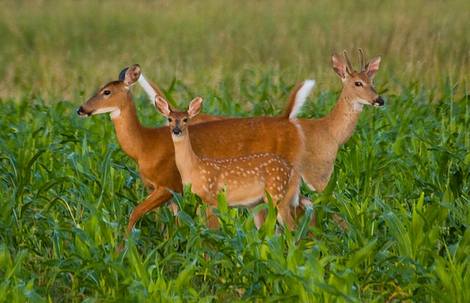
Late summer is not just a stress period for wildlife, its also the time of year to survey white-tailed deer! If you regularly perform surveys on your property, you know the importance of conducting annual population estimates. For those of you that do not, surveys allow deer managers to get a snapshot of the local deer population just prior to hunting season. Without this information, it’s difficult to make harvest recommendations that fall in line with your management objectives.
The first piece of data you need going into the fall is a deer density estimate, or how many acres are available for each deer. In central Texas, where I am located, a good rule of thumb is to 8 to 10 acres of good deer habitat per deer. Free-choice supplemental feeding can drop that to about 6 acres per deer, but one thing to keep in mind is that typically as deer density goes up the quality of individual deer goes down.
The best way to estimate deer density is to perform spotlight surveys. The information collected during spotlight surveys not only includes the number of deer spotted during the census, but also the amount of acreage that was actually observed during the survey. For example, if you have a ranch that is 1,000 acres, you can visually see 200 acres during your census, and you count 20 deer, then you have 100 deer on your property. Without good visibility data the spotlight count data will be worthless.
The next piece of the puzzle you will need to estimate your fall herd is to perform daylight observation surveys for deer. These are simple surveys because you can do them anytime you’re out on the property during daylight hours. And let me stress that although the data is easy to collect it can be of greatest importance! During daylight surveys simply record the number of bucks, does, and fawns observed each day. It’s that simple. But don’t guess! If you can’t tell what it is, don’t skew the data by guessing.
Oh, and you may be wondering why deer are surveyed during the late summer and into the early fall? Well, it’s because it’s at this time of the year that we can readily see deer, so that helps get the most accurate buck to doe ratio for a given area. In addition, essentially all of the fawns are born for the year and are moving around, so we can compare the number of fawns seen on our daylight surveys to the number of does to get a fawn crop estimate.
Here’s an example: If you record daylight observations from August 1st to September 15th and you see 200 bucks, 400 does, and 200 fawns, then we can estimate the herd composition to be 1:2:1, or 1 buck for every 2 does and 1 fawn (25% bucks, 50% does, and 25% fawns). We can also estimate the fawning rate to be 50% since only 1 fawn was observed for every 2 does.
Once fall deer population surveys are completed, deer managers can look at both the herd composition, density estimates, and the latest fawn crop to adjust the harvest rates to achieve their desired goals. Making a sound harvest recommendation is a science with a bit of an art thrown in since habitat conditions and fawn crops change annually, but collecting and analyzing deer survey data should be a part of proper harvest management.